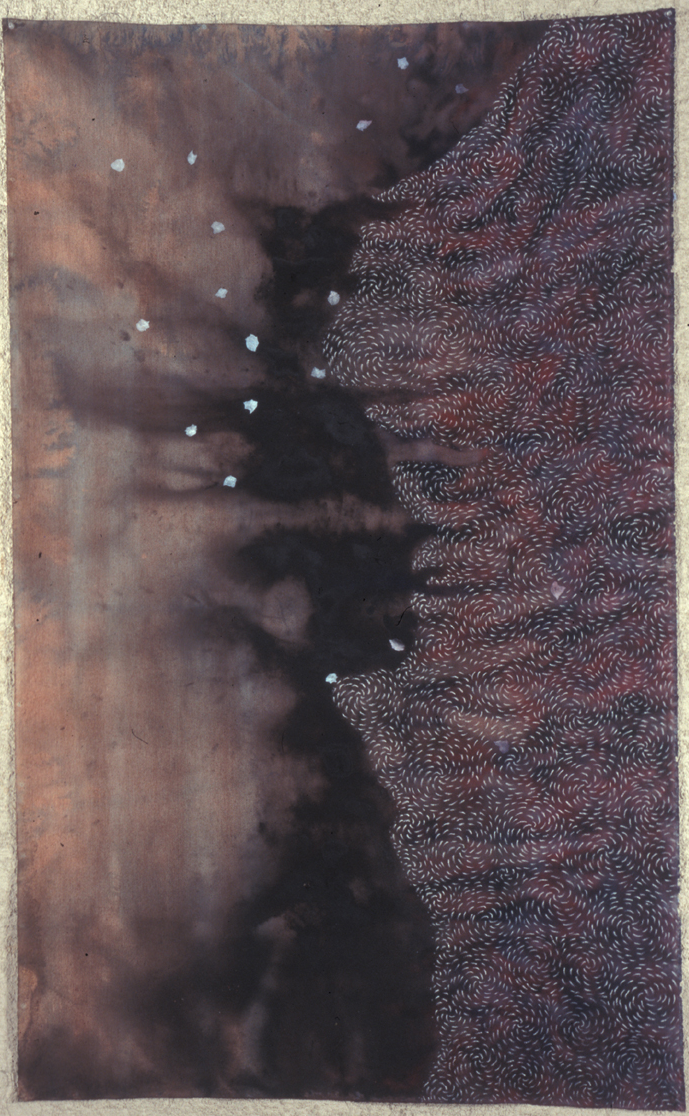Judy Watson
Judy Watson - TateShots - 'Artist's are strange creatures'
Judy Watson was born in Mundubbera, Queensland, in 1959.
Judy Watson was born in Mundubbera, Queensland. Watson's Aboriginal matrilineal family are from Waanyi country in north-west Queensland. Her work reveals hidden stories within Country, working from site and memory, revealing Indigenous histories, following lines of emotional and physical topography that centre on particular places and moments in time. She co-represented Australia in the 1997 Venice Biennale, was awarded the Moët & Chandon Fellowship in 1995, the National Gallery of Victoria’s Clemenger Award in 2006 and, in the same year, the Works on Paper Award at the 23rd National Aboriginal and Torres Strait Islander Award. In 2011 her exhibition waterline was exhibited at the Embassy of Australia, Washington, DC. In 2012 she exhibited in the Sydney Biennale. Her work is held in major Australian and international collections including: National Gallery of Australia; all Australian State Art Galleries; The Tate Modern, London; Taipei Fine Arts Museum; St Louis Art Museum USA; The British Museum, London; Museum of Archaeology and Anthropology, University of Cambridge, UK; Library of Congress, Washington, USA; Kluge-Ruhe Aboriginal Art Collection, University of Virginia, USA; as well as important private collections. She has exhibited widely over the past twenty-five years.
A major survey of works made from 1989-2003 was exhibited at the John Curtin Gallery, Curtin University, W.A. in 2003 and at the Institute of Modern Art Brisbane in 2004. A version of sacred ground, beating heart was toured by Asialink in 2004 in Vietnam, Sri Lanka and the Philippines. It was also exhibited at the University of Queensland Art Museum, Brisbane and toured regional venues in Australia.
She has received major public art commissions including wurreka (2000) a fifty metre etched zinc wall for the Melbourne Museum; walama forecourt (2000), a sculptural installation of woven steel screens and upturned bronze dilly bags at Sydney International Airport; ngarrn-gi land/law (2002), a fifty metre etched zinc wall at the Victorian County Court, Melbourne; heart/land/river (2004,) a large photographic and light piece on glass, installed in the foyer of the Brisbane Magistrates Court; fire and water (2007), a bronze, granite, steel, reeds and sound piece installed at Reconciliation Place, Canberra. museum piece and two halves with baler shell are at the Musée du Quai Branly, Paris (2006). Her work is featured on Gootcha, City Cat ferry, Brisbane. freshwater lens is situated beneath the Turbot Street Overpass, Brisbane. (2010) Watson’s work water memory is in the foyer of the Queensland Institute of Medical Research (2011). Images from etchings of Watson’s heron island suite of were used in the design of Judy’s artwork featured on the exterior of the Brisbane to Cairns Tilt Train (2011).
In 2014, 2015 her works: living well, murri kitchen and fragments will be installed in the grounds of the Townsville Hospital. In 2015 Judy was the recipient of the Australia Council Visual Arts Award. Judy's process lies in revealing hidden stories within Country, working from site and memory, revealing Indigenous histories, following lines of emotional and physical topography that centre on particular places and moments in time.
Judy Watson blood language, a monograph by Judy Watson and Louise Martin-Chew, was published by The Miegunyah Press, Melbourne University Publishing in 2009.
Judy Watson is an Adjunct Professor, Queensland College of Art, Griffith University.
Judy Watson
animal breath 1996
This work was made in my studio in Hautvilliers, France in 1996. It was in a chateau in the grounds of the Dom Perignon Abbey, part of Moet et Chandon.
Most days, during my residency, I would go for a walk through the vineyards and sometimes through the forests behind the Abbey. Sometimes I would see deer in the woods. When it was snowing the sound was muffled and I had a heightened awareness of what was behind me, around me. My senses would be stretched, listening for the crunching of snow, animal breath on my back.
In Australia, being in my own Country in North West Queensland or in other people’s Country, I am very aware of other presences around me when I am walking in those places. When I sit and look and listen, I can hear voices, children laughing, through the sounds of running water. I am not alone.

